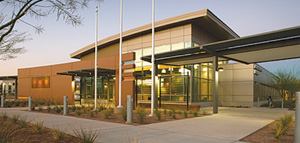Pearl River County Utility Authority Board President Steve Lawle…
The facility’s 82,700 square feet of maintenance space include a system for reclaiming and reusing up to 80% of wash water and will use the rest for an evaporative cooling system. That part of the building has been submitted for LEED Silver certification.
Half of the project’s funding came from federal sources; half from Tempe, Scottsdale, and Maricopa County’s Proposition 400, a 20-year continuation of a half-cent sales tax for transportation projects.
Research Nanotechnology harms treatment procedures
The Water Environment Federation Research Foundation has given a University of Missouri researcher $150,000 to find out at what point silver nanoparticles—which are being used to control odor-causing bacteria in socks and to make washing machines that disinfect clothes by generating the particles—kill the beneficial bacteria that remove ammonia from wastewater.
“Because of the increasing use of silver nanoparticles in consumer products, the risk that this material will be released into sewage lines, wastewater treatment facilities, and, eventually, to rivers, streams, and lakes is of concern,” says Assistant Professor of Civil and Environmental Engineering Zhiqiang Hu.
“Silver nanoparticles are extremely toxic,” he says. “The nanoparticles basically halt the reproduction activity of the good bacteria.”
ResearchNumber of “green” counties up 500%
On the heels of the U.S. Green Building Council’s announcement that it’s issuing new standards for LEED certification in January, an American Institute of Architects and National Association of Counties study shows that 39 counties have green building programs compared to just eight in 2003.
At 19, the East Region represents the greatest number of residents—about 19 million—living in green areas. The Central Region has seven counties; the Mountain Region, which was a smaller portion of the sample, has three; and the Western Region has 10. Nationwide, nine additional counties are developing programs.
The study includes profiles of Alameda County, Calif.; Hennepin County, Minn.; King County, Wash; and Montgomery County, Md., because they provide best-practice examples that can used as models. The work of a group of Florida counties in overcoming legal barriers to promoting sustainable development is also featured.
More than 1,500 buildings have received LEED certification since the program was introduced in 2000, and more than 11,000 are seeking it. Certifications are available in eight categories: new construction, existing buildings, commercial interiors, core and shell, retail, schools, health care, and homes. A category for neighborhood developments is in the pilot stage.
The new standards—called LEED 2009—consolidate various commercial rating systems into one. Points will be allocated differently and reweighed, and the process will be more flexible to adapt to changing technology, account for regional differences, and encourage innovation.






